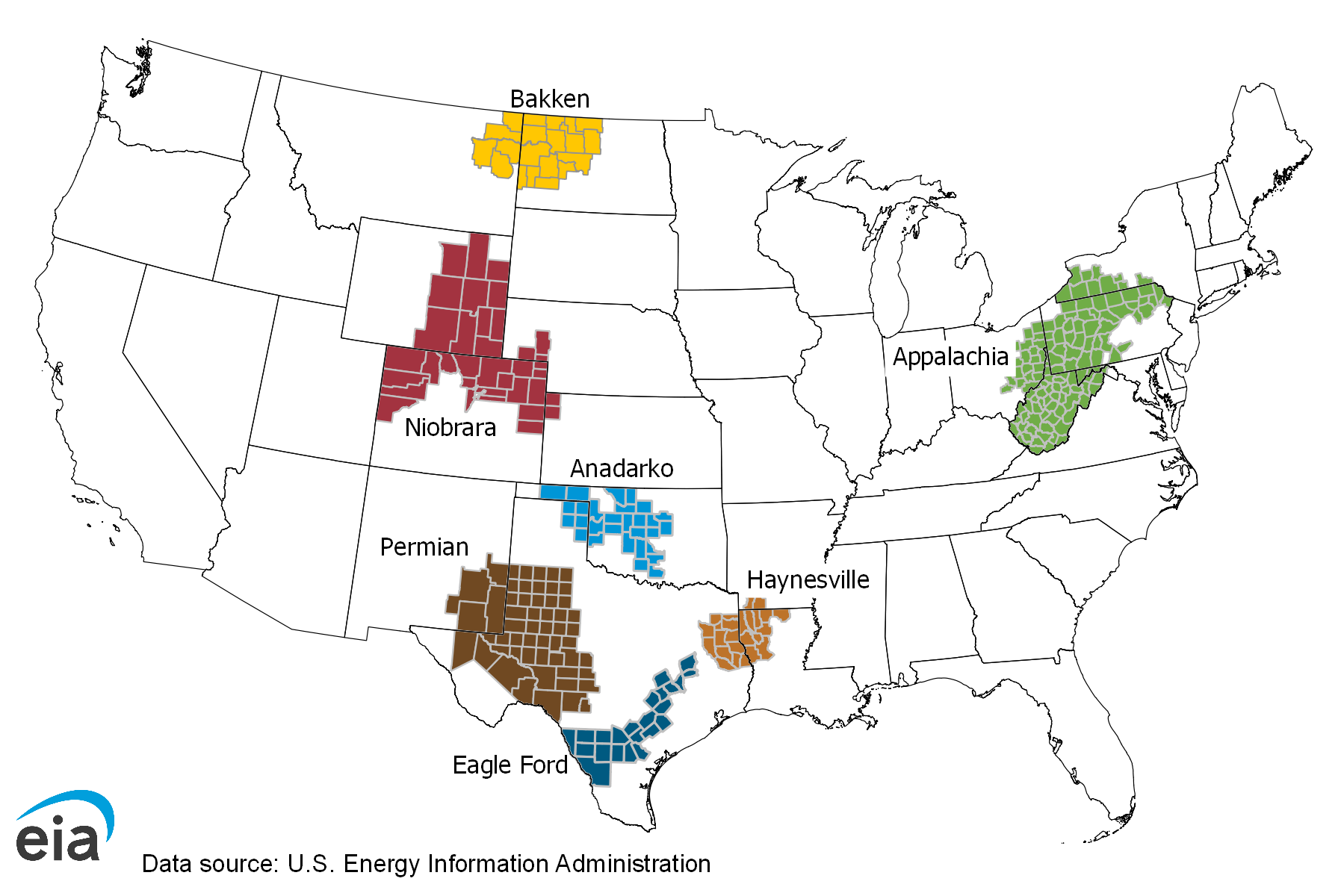
Note: Beginning June 11, 2024, we will publish the shale gas tight oil production data and Drilling Productivity Report data in the Short-Term Energy Outlook (STEO) data tables. These improvements will provide a disaggregated STEO forecast for oil and natural gas production in different regions of the United States.
| New-well oil production per rig barrels/day |
New-well gas production per rig thousand cubic feet/day |
|||||
|---|---|---|---|---|---|---|
| Region | May 2024 | June 2024 | change | May 2024 | June 2024 | change |
| Anadarko | 717 | 719 | 2 | 4,840 | 4,875 | 35 |
| Appalachia | 239 | 241 | 2 | 28,465 | 28,643 | 178 |
| Bakken | 1,745 | 1,747 | 2 | 2,660 | 2,663 | 3 |
| Eagle Ford | 1,635 | 1,639 | 4 | 6,059 | 6,065 | 6 |
| Haynesville | 14 | 14 | - | 13,453 | 13,487 | 34 |
| Niobrara | 1,496 | 1,498 | 2 | 4,622 | 4,678 | 56 |
| Permian | 1,386 | 1,400 | 14 | 2,536 | 2,547 | 11 |
| Rig-weighted average | 1,199 | 1,222 | 23 | 5,964 | 5,831 | (133) |
| Oil production thousand barrels/day |
Gas production million cubic feet/day |
|||||
|---|---|---|---|---|---|---|
| Region | May 2024 | June 2024 | change | May 2024 | June 2024 | change |
| Anadarko | 382 | 383 | 1 | 6,528 | 6,518 | (10) |
| Appalachia | 136 | 135 | (1) | 35,967 | 35,791 | (176) |
| Bakken | 1,313 | 1,313 | - | 3,471 | 3,487 | 16 |
| Eagle Ford | 1,102 | 1,106 | 4 | 7,344 | 7,323 | (21) |
| Haynesville | 32 | 32 | - | 15,606 | 15,339 | (267) |
| Niobrara | 702 | 697 | (5) | 5,359 | 5,344 | (15) |
| Permian | 6,169 | 6,187 | 18 | 25,250 | 25,393 | 143 |
| Total | 9,836 | 9,853 | 17 | 99,525 | 99,195 | (330) |
| Drilled but uncompleted wells (DUC) wells |
|||
|---|---|---|---|
| Region | March 2024 | April 2024 | change |
| Anadarko | 697 | 701 | 4 |
| Appalachia | 819 | 824 | 5 |
| Bakken | 322 | 328 | 6 |
| Eagle Ford | 347 | 345 | (2) |
| Haynesville | 784 | 791 | 7 |
| Niobrara | 644 | 628 | (16) |
| Permian | 891 | 893 | 2 |
| Total | 4,504 | 4,510 | 6 |
The Drilling Productivity Report (DPR) rig productivity metric new-well oil/natural gas production per rig can become unstable during periods of rapid decreases or increases in the number of active rigs and well completions. The metric uses a fixed ratio of estimated total production from new wells divided by the region's monthly rig count, lagged by two months. The metric does not represent new-well oil/natural gas production per newly completed well.
The DPR metric legacy oil/natural gas production change can become unstable during periods of rapid decreases or increases in the volume of well production curtailments or shut-ins. This effect has been observed during winter weather freeze-offs, extreme flooding events, and the 2020 global oil demand contraction. The DPR methodology involves applying smoothing techniques to most of the data series because of inherent noise in the data.
February 2024 Supplement: Initial 180-Day Production Trends in Major U.S. Shale Regions.
September 2021 Supplement: Gas-to-oil ratios in U.S. primary oil-producing regions.
January 2021 Supplement: Base production in North Dakota has fully recovered after a significant reduction.
September 2020 Supplement: With low rig counts, the inventory of drilled but uncompleted (DUC) wells provides short-term reserve for completions of new wells.
August 2020 Supplement: Rig counts fall but new-well production per rig rise as new-well production persists.
March 2020 Supplement: Base production accounts for a material share of total U.S. tight oil production.
-
Related Today in Energy articles
-
- Nearly all new U.S. crude oil and natural gas wells are horizontal or directional
- Number of drilled but uncompleted wells declines
- Texas’s Midland Basin accounted for 15% of U.S. crude oil production in 2020
- EIA estimates drilled but uncompleted wells for key oil and natural gas basins
- U.S. crude oil and natural gas production in 2019 hit records with fewer rigs and wells
- U.S. natural gas production efficiency continued to improve in 2019
- U.S. crude oil and natural gas production increased in 2018, with 10% fewer wells
- U.S. crude oil production efficiency continues year-over-year improvements
- Time between drilling and first production has little effect on oil well production
- Horizontally drilled wells dominate U.S. tight formation production
- The number of drilled but uncompleted wells in the United States continues to climb
- Tight oil development will continue to drive future U.S. crude oil production
